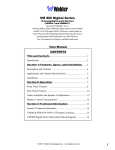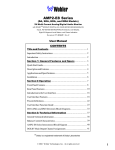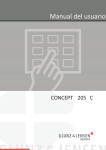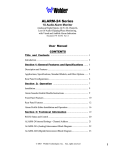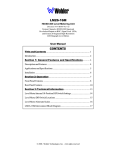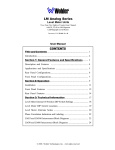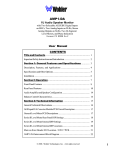Download Wohler ALARM-24 Series User manual
Transcript
ALM26 Series 1U Audio Level Meter Alarm Monitor Analog or Digital Inputs, Up To Twenty-Four Channels, Loss-of-Audio/Clipping/Phase Monitoring, with Audible and Visual Alarm and 26-Segment Hi-Resolution Level Meters Document P/N 821644 Rev-A User Manual CONTENTS Title and Contents ........................................................... 1 Introduction ............................................................................................ 2 Section 1: General Features and Specifications........ 3 Description and Features ....................................................................... 4 Applications, Specifications, Standard Models, and Other Options ...... 5 Rear Panel Configurations ..................................................................... 6 Section 2: Operation ....................................................... 7 Installation ............................................................................................. 9 Alarm Sounder Enable/Disable Instructions .......................................... 9 Front Panel Features .............................................................................. 10 Rear Panel Features ............................................................................... 12 Section 3: Technical Information ................................. 19 LED Bargraph Display Specifications .................................................. 20 ALM26 Internal Settings - Address, Peak Hold, PPM Characteristics... 20 Level Meter Alternative Scales ............................................................. 21 ALM26 (Analog) Interconnect Block Diagram ......................................... 22 ALM26 (Digital) Interconnect Block Diagram .......................................... 23 © 2006 Wohler Technologies Inc. ALL rights reserved 1 Important Safety Instructions 1) Read these instructions. 2) Keep these instructions. 3) Heed all warnings. 4) Follow all instructions. 5) Do not use this apparatus near water. 6) Clean only with dry cloth. 7) Do not block any ventilation openings. Install in accordance with the manufacturer's instructions. 8) Do not install near any heat source such as radiators, heat registers, stoves, or other apparatus (including amplifiers) that produce heat. 9) Do not defeat the safety purpose of the polarized or grounding-type plug. A polarized plug has two blades with one wider than the other. A grounding type plug has two blades and a third grounding prong. The wide blade or the third prong are provided for your safety. If the provided plug does not fit into your outlet, consult an electrician for replacement of the obsolete outlet. 10) Protect the power cord from being walked on or pinched, particularly at plugs convenience receptacles and the point where they exit from the apparatus. 11) Only use attachments/accessories specified by the manufacturer. 12) Use only with the cart stand, tripod, bracket, or table specified by the manufacturer, or sold with the apparatus. When a cart is used, use caution when moving the cart/apparatus combination to avoid injury from tip-over. 13) Unplug this apparatus during lightning storms or when unused for long periods of time. 14) Refer all servicing to qualified service personnel. Servicing is required when the apparatus has been damaged in any way, such as when power-supply cord or plug is damaged, liquid has been spilled or objects have fallen into the apparatus, the apparatus has been exposed to rain or moisture, does not operate normally, or has been dropped. 15) Do not expose this apparatus to rain or moisture. 16) The apparatus shall be connected to a mains socket outlet with a protective earthing connection. CAUTION! In products featuring an audio amplifier and speakers, the surface at the side of the unit, where the audio amplifier heat sink is internally attached, may get very hot after extended operation. When operating the unit excercise caution when touching this surface and ensure that external materials which may be adversely affected by heat are not in contact with it. There is a Hot Surface label (see diagram) attached to the aforementioned surface of the product. Introduction Congratulations on your selection of a Wohler Technologies product. We are confident it represents the best performance and value available, and we guarantee your satisfaction with it. If you have questions or comments you may contact us at: Wohler Technologies, Inc. 31055 Huntwood Avenue Hayward, CA 94544 Phone: (510) 870-0810 Fax: (510) 870-0811 US Toll-Free: 1-888-596-4537 www.wohler.com 2 [email protected] © 2007 Wohler Technologies, Inc. ALL rights reserved ALM26 Series User Manual P/N 821644 Rev-A Section 1 General Features and Specifications Description Features Applications Specifications Standard Models Other Options © 2006 Wohler Technologies Inc. ALL rights reserved 3 ALM26 Series User Manual P/N 821644 Rev-A Section 1: General Features and Specifications ALM26 Series 1U Audio Level Meter Alarm Monitor RESET 1 2 3 4 5 6 7 8 9 10 11 12 13 14 15 16 17 18 19 20 21 22 23 24 POWER RESET WOHLER TECHNOLOGIES ALM26-24D ALL ALM26-24Dxx Front Panel Description The Wohler ALM26 Series systems provide audio level metering and audible and visual alarms for loss of audio, over-range (clipping), and phase/polarity reversal. When a fault condition occurs, it activates individual channel level meter LED behavior and sets off a mutable acoustic alarm. It also energizes a rear-panel relay contact closure(s) for external alarm indication. High-resolution 26-segment tri-color LED bargraph display level meters provide a choice of VU and PPM display characteristics. These level meters are also used to display alarm conditions by flashing groups of red segments. An alarm is activated by audio levels falling outside a pre-determined range for a pre-determined period of time. Each channel may be set individually, or grouped in stereo pairs. Clip and loss alarms are independently indicated on each channel. Carrier alarms (digital units only) and phase alarms are linked in stereo pairs. Individual reset buttons are provided for each channel, as well as a “reset all” button. A Piezo buzzer sounds when any channel indicates any type of alarm. The unit may by easily configured using a Windows-based application. The ALM26 Analog models monitor analog signals and feature "mini" Phoenix stye input connectors as standard. The ALM26 Digital models monitor AES/EBU digital signals with a choice of Phoenix, BNC, or XLR input connectors. Custom variations are available. Features • Centralized monitoring of facility-wide signal conditions • Only one rack space high • Channel pairs may be configured as either mono or stereo on a perpair basis • Up to twenty-four channels can be monitored • Visible alarm indication via LED level meter behavior for each channel • Up to twenty-four high-resolution 26-segment tri-color LED bargraph display level meters • Full duplex RS-232 control/status • Analog or Digital (AES/EBU) models available • Alarms for Signal Loss, Over-range (clipping), and Phase (polarity) reversal. Alarm for loss-of-carrier (loss of digital signal) is available on digital units. • Individual channel reset buttons • Reset All button • Balanced inputs on "mini" or standard Phoenix, BNC, or XLR connectors (depending on model) • Adjustable level thresholds for alarm conditions • Alarm parameters configurable with Windows-based application • Audible piezo alarm (mutable) • Power indication LED NOTE: In the model names throughout this manual, the unspecified channel quantity is indicated by "nn", the unspecified stereo/ mono is indicated by "x", and unspecified connector option is indicated by "/x". 4 © 2006 Wohler Technologies Inc. ALL rights reserved ALM26 Series User Manual P/N 821644 Rev-A Section 1: General Features and Specifications Applications The ALM26 Series audio alarm monitor units are an adaptable and effective way to monitor any Analog or AES/EBU digital audio application. The following are some of the applications where an ALM26 Series unit would prove valuable. · · · Radio Broadcast Station TV Control Room Remote Monitoring Power Specifications Input Specifications AC mains power: 100-250 VAC, 50/60 Hz universal input, auto switching Power consumption: 25W Input Sampling Rate: 32k - 48k Auto (AES) Input Connector(s): Analog: "Mini" Phoenix (standard) AES/EBU: Phoenix (standard) AES/EBU: BNC or XLR (optional) AES Input Impedance: Phoenix: 110 Ω, balanced XLR: 110 Ω, balanced BNC: 75 Ω, unbalanced Dimensions (H x W x D): 1.75 x 19 x 8 inches 45 x 483 x 203 mm >10K Ω, balanced Weight: Analog Input impedance: Physical Specifications 8 lbs./3.5 kg Standard Models ALM26 Series models may be ordered with a choice of 8, 16, and 24 channels standard. Other channel quantities (up to 24) may be ordered as special options. However, ALM26 Models utilizing XLR connector inputs are limited to twelve (12) or fewer channels due to space constraints resulting from the comparatively large size of XLR connectors. NOTE: In the model names below and throughout this manual, the unspecified channel quantity is indicated by "nn". ALM26-nnA: ALM26-nnD: ALM26-nnD/B: ALM26-nnD/X: Analog inputs on "mini" Phoenix connectors Digital (AES/EBU) inputs on standard Phoenix connectors Digital (AES/EBU) inputs on BNC connectors Digital (AES/EBU) inputs on XLR connectors Model Option Naming Key 1st Appended Letter........... Signal 2nd Appended Letter............................. Connector Analog { AD ==Digital (none) = Phoenix (3-Pin Male) /B = BNC (Female) /X = XLR (3-Pin Female) { NOTE: Analog models use 6-pin "mini" Phoenix connectors, Digital models use standard 3-pin Phoenix connectors. Other Options Other options are available by special order including: • Custom combinations of input connectors • 53-segment high resolution displays in 2U rack size • Alternative color boundries Other custom options are possible. Call your dealer or Wohler Technologies to discuss your specific needs. Units are designed to meet, at time of manufacture, all currently applicable product safety and EMC requirements, such as those of CE. Features and specifications subject to improvement without notice. © 2006 Wohler Technologies Inc. ALL rights reserved 5 ALM26 Series User Manual P/N 821644 Rev-A Section 1: General Features and Specifications Rear Panel Configurations The 1U ALM26 rear panels are comprised of modular panel sections. In any given ALM26 model, from one to three of the modular panel sections contain the audio input connectors (unused sections have blank panels), with a fourth remaining section containing the alarm controller features. This arrangement permits mixing of different types of input modules, although such mixes are considered special order items. The number of channels is designated by a number following the ALM26 (i.e., ALM26-24 = twenty-four channels). The following illustration shows three types of input panel section modules (two digital and one analog) available for use in the ALM26 Series. Analog models are referred to with an "A" appended to the standard product name and Digital (AES) models are referred to with a "D" appended. Models featuring Phoenix connector inputs do not append any letter to the model name as these connectors are considered standard. BNC connector inputs append a "/B" to the model name and XLR connector inputs append an "/X". See page 5 for a list of all standard models in the ALM26 series. AES (110 ) TERM TERM CH A AES 75 CH B 3-4 TERM TERM CH A AES CH B CALIB 1-2 TERM CH A CH B AES 75 TERM CH A AES 75 TERM CH B CALIB Please note that XLR models are limited to twelve channels (or less) due to space constraints when using the larger XLR connectors. 75 7-8 5-6 TERM BNC Input Modular Section for ALM26-nnD/B Phoenix Input Modular Section for ALM26-nnD "Mini" Phoenix Input Modular Section for ALM26-nnA Below are examples showing three standard configurations of the ALM26 series rear panels for twenty-four channel units. AES (110 ) AES (110 ) AES (110 ) PORT 1 INTERNAL POWER 19 20 TERM 17 18 11 12 21 22 15 16 TERM TERM 9 10 3 4 13 14 7 8 1 2 TERM TERM UNDERWRITERS LABS SEE POWER SUPPLY LABEL ON SIDE TERM RS232 OPT 23 24 TERM TERM TERM 5 6 TERM TERM TERM ALM26-24D Rear Panel (24-Channel Digital with Standard Phoenix Inputs) 19-20 17-18 TERM TERM AES 11-12 AES 75 75 9-10 TERM TERM AES 3-4 75 TERM TERM AES 75 23-24 INTERNAL POWER 15-16 RS232 OPT AES AES 75 UNDERWRITERS LABS SEE POWER SUPPLY LABEL ON SIDE 75 TERM TERM AES 75 21-22 PORT 1 AES 75 TERM TERM AES 75 1-2 TERM TERM AES AES 75 AES 75 75 13-14 5-6 7-8 CH B CALIB CH A 23-24 CH A CH A 17-18 11-12 21-22 15-16 CH B CH A CH B CH B CH A CH A CH B CH A 9-10 3-4 13-14 7-8 CH B CH B CALIB CH B PORT 1 CH A INTERNAL POWER CH B UNDERWRITERS LABS SEE POWER SUPPLY LABEL ON SIDE 1-2 CH A CH B CALIB CH A CALIB CH B 19-20 CALIB CH A CALIB ALM26-24D/B Rear Panel (24-Channel Digital with BNC Inputs) OPT CH A RS232 CH B 5-6 ALM26-24A Rear Panel (24-Channel Analog with "mini" Phoenix Inputs) 6 © 2006 Wohler Technologies Inc. ALL rights reserved ALM26 Series User Manual P/N 821644 Rev-A Section 2 Operation Installation Alarm Sounder Enable/Disable Instructions Front Panel Features Rear Panel Features © 2006 Wohler Technologies Inc. ALL rights reserved 7 ALM26 Series User Manual P/N 821644 Rev-A (This page intentionally left blank) 8 © 2006 Wohler Technologies Inc. ALL rights reserved Section 2: Operation ALM26 Series User Manual P/N 821644 Rev-A Section 2: Operation Installation Mounting The unit should be mounted where convenient for operating persons, ideally at approximately eye level for best visual monitoring. Heat Dissipation No special considerations for cooling are necessary as long as the ambient temperature inside the rack area does not exceed approximately 40°C (104°F). Mechanical Bracing The chassis is securely attached to the front panel at five points along its surface, not just at the four corners of the chassis ears. This feature will reduce or eliminate rear bracing requirements in many mobile/portable applications. The weight of internal components is distributed fairly evenly around the unit. Audio Connections Connection of the audio feeds is straightforward. Please refer to the system interconnect block diagram on pages 22 and 23 for clarification of the general signal paths into the ALM26 series units. Care should be exercised to avoid mismatched cable types and other similar causes of undesired reflections in RF signal systems. Electrical Interference As with any audio equipment, maximum immunity from electrical interference requires the use of shielded cable; however, satisfactory results can sometimes be obtained without it. The internal circuitry common is connected to the chassis. AC Power The unit's AC mains connection is via a standard IEC inlet, with safety ground connected directly to the unit's chassis. The universal AC input (100-240VAC, 50/60Hz) switching power supply is a self-resetting sealed type, with automatic over-voltage and over-current shutdown. There is no user-replaceable fuse in either the primary or secondary circuit. Alarm Sounder Enable/Disable Instructions All ALM53 Series units feature a Piezo Alarm Sounder located on the front panel (Item 1, page 10). This sounder produces an audible alarm when any channel goes into any alarm condition. This sounder may be disabled or enabled using the instructions below. The sounder may also be enabled and disabled with the WAC software (see Section 5.6, System Settings in the WAC manual for details). To ENABLE the acoustic sounder in the unit, perform the following steps on the front panel: 1) Hold down the Reset All button (Item 6, page 10) 2) Press and release the Channel 3 Reset Alarm button (Item 4, page 10) 3) Release the Reset All button To DISABLE the acoustic sounder in the unit, perform the following steps on the front panel: 1) Hold down the Reset All button (Item 6, page 10) 2) Press and release the Channel 1 Reset Alarm button (Item 4, page 10) 3) Release the Reset All button © 2006 Wohler Technologies Inc. ALL rights reserved 9 ALM26 Series User Manual P/N 821644 Rev-A Section 2: Operation Front Panel Features Please refer to the example in Figure-2a on the following page to familiarize yourself with the front panel features of the ALM26 Series units covered by this manual. The following sections describe these functions and are referenced, by number, to Figure-2a. 1 Alarm Sounder This piezo Alarm Sounder speaker produces an audible alarm when any channel detects any alarm condition. See page 9 for instructions for how to disable or enable the Alarm Sounder. 2 Bargraph Brightness Trim Pot This control is recessed into the front panel and can be accessed using a small screwdriver. Turning it clockwise will increase the relative brightness of the bargraph display LED segments. Adjusting this one control will simultaneously affect the brightness of all bargraph displays on the front panel. 3 Audio Level Meter LED Bargraph Displays (1-24) Audio levels for the audio input sources are displayed via these 26-segment tri-color (green, amber, red) LED Bargraph Display level meters. Each LED Bargraph Display represents a single channel. Each Reset Button (Item 4), located above the LED bargraphs, has a channel number, which corresponds to the numbers found next to the input connectors on the rear panel. Bargraph displays are arranged in groups of four on the front panel, four being the number of input channels available in each input section on the rear panel. ALM26-nnD (Digital): Each group of four bargraph displays is user adjustable for Reference Level calibration and PPM/VU Display Mode via a DIP switch module on the rear panel. This DIP switch module is located between the two input connectors in each input section on the rear panel. See Item B, page 12 for more information regarding the rear panel DIP switch locations and settings. ALM26-nnA (Analog): Each group of four bargraph displays is user adjustable for Reference Level calibration and PPM/VU Display Mode via a DIP switch module on the rear panel. This DIP switch module is located between the two input connectors in each input section on the rear panel. See Item D, page 14 for more information regarding the rear panel DIP switch locations and settings. Alarm Indication Behavior Alarm conditions are indicated by lit LEDs in the 26-segment LED bargraph displays as follows: • Clipping Alarm is indicated in the Top one third region of the bargraph LED segments. • Phase Alarm is indicated in the Middle one third region of the bargraph LED segments. • Loss of Audio is indicated in the Bottom one third region of the bargraph LED segments. • Carrier Loss in a digital unit is indicated by all three regions of LED segments in the left channel, and the top and bottom regions in the right channel turning RED. The center region on the right side is left dark. This creates a flashing red “C” between the two channels. In an alarm condition, the applicable bargraph LED segments (see above) will alternately flash between RED and the color previously displayed in the individual LED segments. To reset the alarm behavior for each individual LED bargraph, press the Reset Button directly above the bargraph (Item 4). To simultaneously reset the alarm behavior of ALL the bargraphs in the unit, press the Reset All Button (Item 6). See Alarm Resets in Section 7.0 in the Wohler Alarm Controller (WAC) manual (P/N 821642) for details on reset function modes available through the WAC software. Note that these buttons also reset the peak-hold segment when manual peak hold mode is enabled (see page 20). NOTE: Each of the alarm features described above may be enabled or disabled on a per channel basis or on a unit wide basis through the WAC (Wohler Alarm Control) software. See Setting Alarm Channel Parameters, Section 5.5 and System Settings, Section 5.6 in the WAC manual (P/N 821642) for details. 4 Reset Button (1-24) These momentary push-buttons reset the level meter alarm function for each individual channel. When a button is pushed, only the level meter located directly below it is reset. 5 Power Indication LED This LED lights up GREEN to indicate the ALM26 Series model is connected to operational mains power. 6 Reset All Button This momentary push-button simultaneously resets the level meter alarm function for ALL the channels in the unit. Note that this button will also reset the peak-hold segment of all the meters with manual peak hold mode enabled (see page 20). 10 © 2006 Wohler Technologies Inc. ALL rights reserved ALM26 Series User Manual P/N 821644 Rev-A Section 2: Operation WOHLER TECHNOLOGIES 1 2 4 RESET 1 2 3 3 4 5 6 7 8 9 10 11 12 13 14 15 16 17 18 19 20 21 22 23 24 5 POWER RESET ALL ALM26-24D 6 Figure-2a: Front Panel Features © 2006 Wohler Technologies Inc. ALL rights reserved 11 ALM26 Series User Manual P/N 821644 Rev-A Section 2: Operation Rear Panel Features Please refer to Figure-2b on the following page to familiarize yourself with the rear panel features of the ALM26 Series units covered by this manual. The following sections describe these features and are referenced, by letter, to Figure-2b. A Digital (AES) Audio Inputs (ALM26-nnD Only) Each input connector receives an AES digital signal from which two channels are derived. A1 Phoenix Connectors (Standard) These Phoenix (or XLR) connectors are configured for a balanced (110 Ω impedance) connection. Channel numbers are displayed on a label to the side of each connector and correspond to the channel numbers above the associated LED indicators on the front panel. Connector pinout information is silk-screened just below each connector. A2 BNC Connectors (Optional) These BNC connectors are configured for an unbalanced (75 Ω impedance) connection. Channel numbers displayed on a label above or below each connector and correspond to the channel numbers above the associated LED indicators on the front panel. B Digital AES Termination, Reference Level, and Display Mode DIP Switch (ALM26-nnD Only) This DIP switch sets the Termination for the input connectors, and the bargraph Display Mode and Reference Level for the associated bargraph displays. Each DIP switch module affects only the four channels (two input connectors) within the section in which it is located. See the descriptions and diagram below for setting information. Termination: Switch sections 1 (left connector) and 6 (right connector) respectively set the termination for the connector inputs in each 4channel input section. The respective DIP switch section should be moved to the UP position to UNTERMINATE the connector if the input signal is fed to downstream equipment. The respective DIP switch section should be moved to the DOWN position to TERMINATE the connector if the input signal is not fed to downstream equipment. The factory default setting is TERMINATED for each input connector. See diagam below for settings. Reference Level: DIP switch sections 2 and 3 determine the Reference Level, which adjusts the level of the input signal and the resultant level displayed on the LED bargraphs. Factory setting is -20 dBfs. See diagam below for settings. Bargraph Display Modes: DIP switch sections 4 and 5 determine how peak levels are displayed for the four associated meters on the front panel. There are four possible settings; VU Bargraph Only, VU Bargraph with PPM Floating Segment, PPM Bargraph Only, and PPM Bargraph with PPM Floating Segment. The factory default setting is VU Bargraph with PPM Floating Segment. See diagam below for settings. See the ALM26 Internal Settings - Address, Peak Hold, PPM Characteristics diagram on page 23 for how to set the Peak Hold and PPM Ballistics characteristics. (Continued) 12 © 2006 Wohler Technologies Inc. ALL rights reserved TERM TERM AES (110 ) TERM TERM 17-18 17 18 21 22 11 12 15 16 11-12 TERM TERM AES (110 ) TERM TERM TERM TERM 9-10 9 10 13 14 3 4 7 8 3-4 TERM TERM AES (110 ) TERM TERM TERM TERM TERM TERM 1-2 1 2 5 6 5-6 1-2 75 AES AES AES AES 5-6 CH B CH B AES CH A 75 AES CH B CH A 75 7-8 CH A CH B 75 3-4 7-8 CH A 75 9-10 13-14 OPT OPT OPT PORT 1 PORT 1 PORT 1 RS232 RS232 RS232 INTERNAL POWER UNDERWRITERS LABS SEE POWER SUPPLY LABEL ON SIDE INTERNAL POWER UNDERWRITERS LABS SEE POWER SUPPLY LABEL ON SIDE INTERNAL POWER UNDERWRITERS LABS SEE POWER SUPPLY LABEL ON SIDE 13 © 2006 Wohler Technologies Inc. ALL rights reserved 19 20 23 24 TERM TERM 13-14 CH B CH B AES AES TERM TERM CH A 75 AES CH B CH A 75 15-16 CH A CH B 75 11-12 15-16 CH A 75 17-18 21-22 CALIB 19-20 21-22 CH B CH B AES TERM TERM CH A AES CH B CH A CALIB 75 CH A CH B CALIB 75 23-24 CH A CALIB AES 75 19-20 23-24 CALIB ALM26-24D ALM26-24D/B ALM26-24A CALIB Section 2: Operation ALM26 Series User Manual P/N 821644 Rev-A Figure-2b: Rear Panel Features ALM26 Series User Manual P/N 821644 Rev-A Section 2: Operation Rear Panel Features (Continued) C Analog Audio Inputs (ALM26-nnA Only) The Analog units have balanced (>10K Ω impedance) inputs terminated in 6-pin "mini" Phoenix connectors. There are two separate analog signals; one signal to the left three pins (CH A) and the second signal to the right three pins (CH B). There are two input connectors per input section (4 channels). Channel numbers are displayed on a label to the side of each connector and correspond to the channel numbers above the associated bargraph meters on the front panel. Pin-out information is silk-screened on the rear panel directly below each connector. D Analog Line Level, Reference Level, and Display Mode DIP Switch (ALM26-nnA Only) This DIP switch sets the Line Level Calibration, Reference Level, and PPM/VU Display Mode. Each DIP switch module affects only the four channels within the section in which it is located. See the descriptions and diagram below for setting information. Line Level (Auto) Calibration: The unit is calibrated at the factory. To recalibrate: 1) Turn on the power. 2) Apply the desired reference level (nominal 0) signal to all four channels. 3) Make sure the Reference Level DIP sections (2 and 3) are set to the nearest level of the input signal being applied for calibration (i.e., 0, +4, +6 or +8). The user should make sure that the signal applied to all four channels is within +/- 4 dB of the reference level selected by DIP switch sections 2 and 3. 4) Place DIP section 1 in the DOWN position. 5) Wait 10 seconds. The unit will remove the previous calibration and the new calibration will be applied. 6) Place DIP section 1 in the UP position and return unit to service. 7) Only ONE auto-calibration attempt may be made for each cycling of AC power to the unit. Once the Line Level Calibration DIP switch has been placed in the CAL position, it is necessary to cycle the power before that DIP switch will be functional again, EVEN if a calibration attempt was unsuccessful. If one wishes to calibrate again, turn off the power to the unit and repeat steps 1 through 6. Reference Level: DIP switch sections 2 and 3 determine the Reference Level, which adjusts the level of the input signal and the resultant level displayed on the LED bargraphs. Factory setting is +4 dB. See diagram below for settings. Bargraph Display Mode: DIP switch sections 4 and 5 determine how peak levels are displayed for the four associated meters on the front panel. There are four possible settings; VU Bargraph Only, VU Bargraph with PPM Floating Segment, PPM Bargraph Only, and PPM Bargraph with PPM Floating Segment. The factory default setting is VU Bargraph with PPM Floating Segment. See diagam below for settings. See the ALM26 Internal Settings - Address, Peak Hold, PPM Characteristics diagram on page 23 for how to set the Peak Hold and PPM Ballistics characteristics. NOTE: For more accurate indication of signal levels, analog meters are tuned to effect a “rounding” function which occur BETWEEN the thresholds of any two bargraph segments. This means the level meter zero LED segment will turn on at one-half the smallest spacing between LED segments (mid-scale resolution) before that segment's scale indication. This "rounding offset" is 0.5 dB for the Analog (extended VU), Digital, Nordic, BBC, and DIN scales. It is 0.25 dB for the VU scale. For example, using the Analog (extended VU) scale, a meter calibrated for a +4 dBu nominal level will actually turn the zero LED segment of the level meter on at 3.5 dBu and all segments will turn on at 0.5 dBu before that segment's silk-screened scale indication. (Continued) 14 © 2006 Wohler Technologies Inc. ALL rights reserved TERM TERM AES (110 ) TERM TERM TERM TERM 17-18 21 22 17 18 15 16 11 12 11-12 TERM TERM AES (110 ) TERM TERM TERM TERM 9-10 13 14 9 10 7 8 3 4 3-4 TERM TERM AES (110 ) TERM TERM TERM TERM 1-2 1 2 5 6 75 1-2 5-6 OPT OPT OPT PORT 1 PORT 1 PORT 1 RS232 RS232 RS232 INTERNAL POWER UNDERWRITERS LABS SEE POWER SUPPLY LABEL ON SIDE INTERNAL POWER UNDERWRITERS LABS SEE POWER SUPPLY LABEL ON SIDE INTERNAL POWER UNDERWRITERS LABS SEE POWER SUPPLY LABEL ON SIDE 15 © 2006 Wohler Technologies Inc. ALL rights reserved 19 20 23 24 19-20 CH B AES AES TERM TERM AES AES CH B AES AES 5-6 AES 7-8 CH A CH B 75 3-4 7-8 CH A 75 9-10 13-14 CH B AES TERM TERM 13-14 CH A AES AES CH B CH B CALIB AES CH A CH B CALIB 75 CH A CALIB 75 11-12 15-16 CH B 75 15-16 CH A 75 21-22 CH B 75 TERM TERM CH A 17-18 21-22 CH A 75 CH B CH B CH A 75 CH A CH B CH A 75 23-24 CH A CALIB AES 75 19-20 23-24 CALIB ALM26-24D ALM26-24D/B ALM26-24A CALIB Section 2: Operation ALM26 Series User Manual P/N 821644 Rev-A Figure-2b: Rear Panel Features ALM26 Series User Manual P/N 821644 Rev-A Section 2: Operation Rear Panel Features (Continued) E Option Select Switch This 10-position BCD (Binary Coded Decimal) rotary switch is used to set operation of the unit. It can be accessed using a small flathead screwdriver or similar tool. See table below for settings. Please note that choosing alternate scales may require a change to the scale indication silk-screening next to the bargraph display level meters on the front panel. See page 24 (Level Meter Alternative Scales) for more information. F Port 1 Connector This DB-25 connector (Port 1) is used to convey alarm conditions to outboard equipment. This port has isolated contact closures, which indicate Alarm conditions for the associated channel or channel pair. These contacts are normally open and close on alarm. In units with twelve or fewer channels, each relay represents a single channel. In units with more than twelve channels, each relay represents a pair of channels. A summary contact pair exists between pins 1 and 14. If any relay pair in the unit closes, the summary contacts also close. Example: If channel 15 or 16 trips into alarm, a contact closure will occur between pins 9 and 21 and between pins 1 and 14 for the duration of the alarm. See the table to the right for connector pinout details. NOTE: An option is available to make the relay operation independent of the alarm indications and resets. Contact the factory for details and instructions on enabling this option. G Serial Control Connector This connector is used for Remote Control and for software upgrades of the product. See table below for pinout information. H Power Input Connector Attach a standard IEC-320 power cord between this connector and mains power (100 - 240VAC nominal, 50/60 Hz). The front panel Power Indication LED (Item 5, page 10) will glow GREEN to indicate operating voltages are present. 16 © 2006 Wohler Technologies Inc. ALL rights reserved TERM TERM AES (110 ) TERM TERM TERM TERM 17-18 21 22 17 18 15 16 11 12 11-12 TERM TERM AES (110 ) TERM TERM TERM TERM 9-10 13 14 9 10 7 8 3 4 3-4 TERM TERM AES (110 ) TERM TERM TERM TERM 1-2 1 2 5 6 75 1-2 5-6 OPT OPT OPT PORT 1 PORT 1 PORT 1 RS232 RS232 RS232 INTERNAL POWER UNDERWRITERS LABS SEE POWER SUPPLY LABEL ON SIDE INTERNAL POWER UNDERWRITERS LABS SEE POWER SUPPLY LABEL ON SIDE INTERNAL POWER UNDERWRITERS LABS SEE POWER SUPPLY LABEL ON SIDE 17 © 2006 Wohler Technologies Inc. ALL rights reserved 19 20 23 24 19-20 CH B AES AES TERM TERM 75 AES CH B AES AES 5-6 75 7-8 CH A CH B 75 3-4 7-8 CH A 75 9-10 13-14 CH B AES TERM TERM 13-14 CH A 75 AES CH B CH B CALIB AES CH A CH B CALIB 75 CH A CALIB 75 11-12 15-16 CH B AES 15-16 CH A 75 21-22 CH B AES TERM TERM CH A 17-18 21-22 CH A 75 CH B CH B CH A AES CH A CH B CH A 75 23-24 CH A CALIB AES 75 19-20 23-24 CALIB ALARM-24D ALARM-24D/B ALARM-24A CALIB Section 2: Operation ALM26 Series User Manual P/N 821644 Rev-A Figure-2b: Rear Panel Features ALM26 Series User Manual P/N 821644 Rev-A (This page intentionally left blank) 18 © 2006 Wohler Technologies Inc. ALL rights reserved Section 2: Operation ALM26 Series User Manual P/N 821644 Rev-A Section 3 Technical Information LED Bargraph Display Specifications ALM26 Internal Settings - Address, Peak Hold, PPM Characteristics Level Meter Alternative Scales ALM26 (Analog) Interconnect Block Diagram ALM26 (Digital) Interconnect Block Diagram © 2006 Wohler Technologies Inc. ALL rights reserved 19 ALM26 Series User Manual P/N 821644 Rev-A Section 3: Technical Information LED Bargraph Display Specifications Level meter type: LED bargraph Segment quantity: 26 Level gain (DIP switch selectable): 0, +4, +6, +8 dB Bargraph Length: 1.078" (27.85 mm) LED segment size: 0.14" x 0.028" (3.57 x 0.7 mm) LED segment pitch: 0.041" (1.05 mm) Segment display color: Tri-color (red, amber, green) Peak emmision wavelength: Green: 570 nm, Red: 630 nm Segment brighness, (If = 20 mA): 3.5 mcd Segment brightness, uniformity: <10% difference between segments Adjacent segment "Off" brightness: <1% of brightness of active segment Notes: 1) For level meter Input Reference and Display Mode settings, see pages 12 (Digital) and 14 (Analog). 2) For level meter Addressing, Peak Hold, and PPM Characteristics settings, see this page, below. 3) For level meter Alternate Scales information, see page 21. ALM26 Internal Settings - Address, Peak Hold, PPM Characteristics ALM26 Internal 10-Position DIP Switch Settings Address (Factory Set) Peak Hold (Bargraph Display) PPM Ballistics (Bargraph Display) 5 6 1 2 3 4 7 8 Peak Hold - Manual Channels 1 to 4 1 2 3 4 5 6 7 8 9 10 1 2 3 4 5 6 7 8 9 10 IEC268-10, Type 1 1 2 3 4 5 6 7 8 9 10 5 6 1 2 3 4 7 8 Channels 5 to 8 1 2 3 4 5 6 7 8 9 10 IEC268-10, Type 2 Peak Hold - 3 Second 1 2 3 4 5 6 7 8 9 10 1 2 3 4 1 2 3 4 5 6 7 8 9 10 7 8 5 6 Channels 9 to 12 1 2 3 4 5 6 7 8 9 10 DIN 45406 Peak Hold - 10 Second 1 2 3 4 5 6 7 8 9 10 1 2 3 4 1 2 3 4 5 6 7 8 9 10 7 8 5 6 Peak Hold - Off Channels 13 to 16 1 2 3 4 5 6 7 8 9 10 1 2 3 4 5 6 7 8 9 10 Single Sample Return Time (SSRT) 1 2 3 4 5 6 7 8 9 10 1 2 3 4 Factory Settings Channels 17 to 20 1 2 3 4 5 6 7 8 9 10 10 9 1 2 3 4 Channels 21 to 24 RM (Not Used) PC (Not Used) 1 2 3 4 5 6 7 8 9 10 1 2 3 4 5 6 7 8 9 10 1 2 3 4 5 6 7 8 9 10 Note: DIP switch is located on Analog Input PCB (919174) or Digital Input PCB (919175) . NOTE: The Peak Hold feature (if enabled) will only be visible if a floating segment is also enabled (see Bargraph Display Modes sections on pages 12 and 14). PPM Characteristics (Ballistics): The PPM characteristics determine the Integration Time (rise time) and Return Time (fall time) of the level meter. The Integration Time is the time it takes for the lighted segments of the level meter, after application of a 5 Khz tone at a certain reference level, to rise within a specified number of dB of that level. Return Time is the time it takes for the lighted segments of the level meter to fall a certain number of dB after removal of a 5 Khz tone of a certain reference level. The PPM characteristics available for selection using DIP switch sections 7 and 8 of the 10-position Internal DIP Switch (as shown in the above diagram) are as follows: 20 IEC268-10, Type 1: Integration Time is 5 ms (-2 dB), Return Time is 1.7 seconds (20 dB) IEC268-10, Type 2: Integration Time is 10 ms (-2 dB), Return Time is 2.8 seconds (24 dB) DIN 45406: Integration Time is 5 ms (-2 dB), Return Time is 1.5 seconds (20 dB) Single Sample: Integration Time is a single sample, Return Time is 1.5 seconds (20 dB) © 2006 Wohler Technologies Inc. ALL rights reserved ALM26 Series User Manual P/N 821644 Rev-A Level Meter Alternative Scales The standard scales used on the ALM26 Series level meters are the Extended VU scale for analog models and AES scale for digital models (see diagram below). However, if alternative scale characteristics are selected for the level meters using the Option Select Switch (Item F, page 16), it is recommended that a label with the appropriate scale be applied to the front panel LED bargraph level meters. Alternative scales include the VU, BBC, NORDIC, and DIN scales (see diagram below for scale comparison). Contact Wohler Technologies for information about alternative scale labels for the ALM26 Series units. Note that the color boundaries for all of the scales (standard and non-standard) can be modified. Contact the factory for instructions. 0 1 2 3 4 5 6 7 8 9 10 11 12 13 14 15 16 17 18 19 20 21 22 23 24 25 26 -6 -12 -18 -24 -30 -36 -42 -48 AES (Digital) Scale (Standard) 1 2 3 4 5 6 7 8 9 10 11 12 13 14 15 16 17 18 19 20 21 22 23 24 25 26 +12 +6 0 -6 -12 -18 -24 -30 -40 -50 Extended VU (Analog) Scale (Standard) 1 2 3 4 5 6 7 8 9 10 11 12 13 14 15 16 17 18 19 20 21 22 23 24 25 26 0 -3 -6 -9 -12 -15 -18 -21 -24 -27 -30 -40 -50 Alternate AES Scale (Custom) +3 1 2 3 4 5 6 7 8 9 10 11 12 13 14 15 16 17 18 19 20 21 22 23 24 25 26 +2 +1 0 -1 -2 -3 -5 -7 -10 -20 VU Scale 1 2 3 4 5 6 7 8 9 10 11 12 13 14 15 16 17 18 19 20 21 22 23 24 25 26 7 6 5 4 3 2 1 BBC Scale © 2006 Wohler Technologies Inc. ALL rights reserved +12 1 2 3 4 5 6 7 8 9 10 11 12 13 14 15 16 17 18 19 20 21 22 23 24 25 26 +9 +6 +3 T -3 -6 -9 -18 -24 -30 -36 -42 NORDIC Scale 1 2 3 4 5 6 7 8 9 10 11 12 13 14 15 16 17 18 19 20 21 22 23 24 25 26 +5 0 -5 -10 -20 -30 -40 -50 DIN Scale 21 ALM26 (Analog) Interconnect Block Diagram ALM26 Series User Manual P/N 821644 Rev-A 22 © 2006 Wohler Technologies Inc. ALL rights reserved Section 3: Technical Information Section 3: Technical Information ALM26 (Digital) Interconnect Block Diagram ALM26 Series User Manual P/N 821644 Rev-A © 2006 Wohler Technologies Inc. ALL rights reserved 23 ALM26 Series User Manual P/N 821644 Rev-A Wohler Technologies, Inc. Wohler 31055Technologies, Huntwood Avenue Inc. 31055 Huntwood Avenue Hayward, CA 94544 Hayward, CA(510) 94544 1-888-596-4537 Fax: 870-0811 web: www.wohler.com Phone: (510) 870-0810 Fax: (510) 870-0811 e-mail: [email protected] US Toll-Free: 1-888-596-4537 www.wohler.com [email protected] 24 © 2006 Wohler Technologies Inc. ALL rights reserved
























